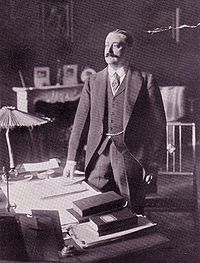Frigyes Szapáry
| Frigyes Szapáry | |
|---|---|
 |
|
| Chef de cabinet of the Imperial Foreign Minister | |
|
In office 10 December 1909 – 20 April 1912 |
|
| Preceded by | Maximilian Freiherr von Gagern |
| Succeeded by | Alexander Graf von Hoyos, Freiherr zu Stichsenstein |
| Second Section Chief in the Imperial Foreign Ministry | |
|
In office 20 April 1912 – 1 October 1913 |
|
| Preceded by | Karl Freiherr von Macchio |
| Succeeded by | Johann Graf Forgách von Ghymes und Gács |
| Austro-Hungarian Ambassador to Russia | |
|
In office 1 October 1913 – 6 August 1914 |
|
| Preceded by | Duglas Graf von Thurn und Valsássina-Como-Vercelli |
| Succeeded by | None |
| Personal details | |
| Born |
15 November 1869 Budapest, Austria-Hungary (now Hungary) |
| Died | 18 March 1935 (aged 65) Vienna, Austria |
| Spouse(s) | Hedwig, née Prinzessin zu Windisch-Grätz (1878–1918) |
Count Frigyes Szapáry de Szapár, Muraszombat et Széchy-Sziget (15 November 1869 – 18 March 1935), was an Austro-Hungarian diplomat of Hungarian origin serving as ambassador at St. Petersburg at the outbreak of World War I and who played a key role during the July Crisis of 1914.
Born in Budapest on 15 November 1869 into a prominent Hungarian noble family as the second son of László Szapáry (1831–1883), an Austro-Hungarian general who had played a leading role in the occupation of Bosnia and Herzegovina in 1878, and his wife Marianne (née Gräfin von Grünne). He was also a cousin of Count Gyula Szapáry, Prime Minister of Hungary from 1890 to 1892.
On 27 April 1908, he married Hedwig (1878–1918), daughter of Alfred Fürst zu Windisch-Grätz, who had been Minister President of Austria from 1893 to 1895 and served as President of the Upper Chamber. The couple had four children of which the daughter Marianne (1911–1998) was the mother of Princess Michael of Kent.
Following studies in law, Count Szapáry joined the Austro-Hungarian foreign service and began his diplomatic career in 1895 as an attaché in Rome, followed by postings in Berlin in 1899 and Munich in 1903. In 1907, he returned to Vienna to serve in the Foreign Ministry at the Ballhausplatz and made a rapid career. Considered a rising star he was appointed as chef de cabinet to Foreign Minister Count Lexa von Aehrenthal in December 1909, a post that allowed him to exercise considerable influence over policy-making. Considered a protégé of Aehrenthal, he belonged to a group of younger diplomats (together with Count von Hoyos and Count von Forgách) who believed that the Dual Monarchy could only be saved from disintegration by a more aggressive and dynamic foreign policy. During the Balkan crisis, he had favoured armed intervention against Serbia. In April 1912, he was appointed to Second Section Chief, which was equivalent to head of the Political Section, in a period of international turmoil. Described as "gifted, quick, hard-working, and a bit mysterious", Aehrenthal's successor Count Berchtold lauded him as for "his outstanding skill in handling political issues and his judgment which far exceeded the norm".
...
Wikipedia
